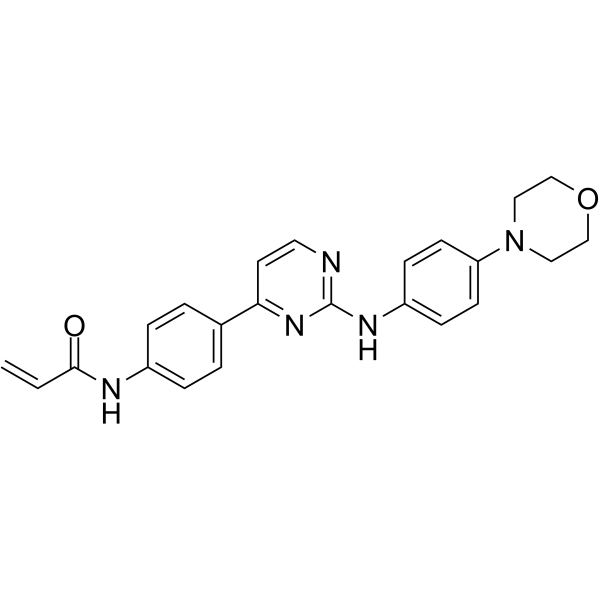2412734-00-8
| Name | JAK3-IN-11 |
|---|
| Description | JAK3-IN-11 (Compound 12), a potent, noncytotoxic, irreversible, orally active JAK3 inhibitor with IC50 value of 1.7 nM, has excellent selectivity (>588-fold compared to other JAK isoforms), covalently bind to the ATP-binding pocket in JAK3. JAK3-IN-11 strongly inhibits JAK3-dependent signaling and T cell proliferation, is a promising tool for study autoimmune diseases[1]. |
|---|---|
| Related Catalog | |
| Target |
JAK3:1.7 nM (IC50) JAK2:1 μM (IC50) JAK1:1.32 μM (IC50) |
| In Vitro | JAK3-IN-11 (Compound 12) (10 μM, 72 h) has no obvious cytotoxicity at a concentration of 10 μM[1]. JAK3-IN-11 (Compound 12) (72 h) displays strong inhibition for T cell proliferation with IC50 values of 0.83 μM (anti-CD3/CD28 stimulation) and 0.77 μM (IL-2 stimulation)[1]. JAK3-IN-11 (Compound 12) (0-10 μM, 1h) abrogates IL-2 or IL-15-induced phosphorylation of STAT5 in a concentration-dependent manner[1]. JAK3-IN-11 (Compound 12) covalently binds to JAK3 and irreversibly inhibits JAK3[1]. Cell Proliferation Assay[1] Cell Line: Mouse T cells in complete RPMI1640 medium then exposed to anti-CD3/anti-CD28 or IL-2. Concentration: Incubation Time: 72 h. Result: Displayed strong inhibition for T cell proliferation with an IC50 values of 0.83 μM (anti-CD3/CD28 stimulation) and 0.77 μM (IL-2 stimulation), showed obvious significant immunosuppressive activity under selective inhibition of JAK3. Western Blot Analysis[1] Cell Line: Purified T cells were pre-activated coated with anti-CD3 and anti-CD28 for 72 h, then cultured with IL-2 (50 U/mL) for 36 h, then, cultured without IL-2 for 36 h Concentration: 0.01, 0.1, 1, 10 μM. Incubation Time: 1 h. Result: Abrogated IL-2 or IL-15-induced phosphorylation of STAT5 in a concentration-dependent manner. |
| In Vivo | JAK3-IN-11 (Compound 12) (Oxazolone (OXZ)-induced DTH Balb/c mice; 0-30 mg/kg; PO, prior to and during the challenge phase, 6 days) inhibits oxazolone (OXZ)-induced delayed type hypersensitivity (DTH) responses in a dose-dependent manner[1]. Animal Model: Oxazolone (OXZ)-induced DTH Balb/c mice model[1]. Dosage: 30, 10, and 3 mg/kg. Administration: PO, prior to and during the challenge phase, 6 days. Result: Inhibited oxazolone (OXZ)-induced delayed type hypersensitivity (DTH) responses in a dose-dependent manner. Animal Model: Male ICR mice[1]. Dosage: 30 mg/kg for oral gavage, 10 mg/kg for intravenous administration. Administration: Pharmacokinetic Analysis Result: Preliminary pharmacokinetic data of JAK3-IN-11 (Compound 12) in male ICR Mice[1] Male ICR mice, 30 mg/kg for oral gavage, 10 mg/kg for intravenous administration[1]. Compound 12 iv (10 mg/kg) po (30 mg/kg) AUC(0-t) (mg/L*h)a 1244.41 ± 77.83 889.42 ± 48.32 AUC(0-∞) (mg/L*h) 1274.41 ± 57.18 897.12 ± 56.72 MRT (0-∞) (h)b 0.73 ± 0.08 1.42 ± 0.38 Vz (L/kg)c 8.36 ± 1.83 220.42 ± 24.71 CLz (L/h/kg)d 8.15 ± 1.21 97.14 ± 20.87 t1/2 (h)e 0.47 ± 0.06 1.52 ± 0.34 Cmax (mg/L)f 8763.23 ± 324.65 2008.21 ± 189.44 Bioavailability(%)g 23.82%a Area under the concentration time curve. b Mean residence time. c Volume in steady state. d Plasma clearance. e Terminal half-life. f Peak plasma concentrations. g Bioavailability = AUC0-t(po)/AUC0-t × 100%. |
| References |
| Molecular Formula | C23H23N5O2 |
|---|---|
| Molecular Weight | 401.46 |
